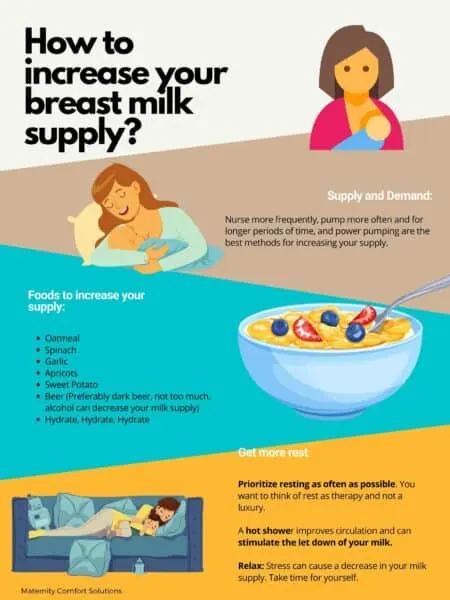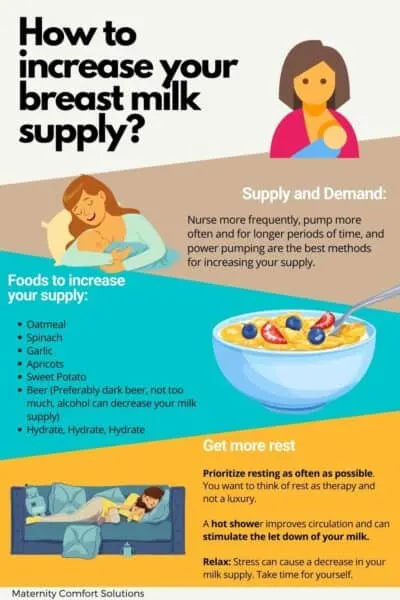Updated November 12, 2022

Are you looking for ways to increase your breast milk supply fast?
You are not alone.
Breastfeeding your newborn can be a challenge.
It is so important that you don’t get overwhelmed if you find breastfeeding particularly demanding at first.
Struggling to produce an adequate breast milk supply is not uncommon.
BUT… that doesn’t mean there is nothing you can do.
In a hurry?
If you are having problems with breastfeeding and low supply, The Ultimate Breastfeeding Class by Milkology is the ONLINE class you need to take today!
Unfortunately, breastfeeding for many women can be difficult. You may ultimately need a consultation with a lactation consultant.
If you are struggling with breastfeeding and want to continue, it is important to reach out for help sooner, rather than later.

Stay with me and let’s dig into some of the ways you can increase your milk supply
First things first, It is important to address the most critical question every breastfeeding mom should be asking:
Is my baby getting enough breast milk to provide adequate calories and hydration?
To be sure your baby is getting enough breast milk it is critical to monitor the following parameters:
- Are you changing at least 6 wet diapers each day after the first few days of colostrum?
- Is your baby latching on properly and feeding every 2 to 3 hours?
- Does your baby seem content after breastfeeding?
- Is your baby sleeping between feedings?
- Are your breasts softer (not engorged) after breastfeeding?
- Can you visibly see your baby swallowing milk?
- Is your baby having two or more bowel movements during the first few weeks?
Weight gain is the most objective indication your baby is getting adequate calories.
Though breastfed newborns can lose up to 10% of their body weight during their first few days of life, subsequent consistent weight gain is the best indication your newborn is getting adequate nutrition (calories).
The early weight loss is usually gained back within 2 weeks.
When your baby starts gaining weight, weight gain should be up to 8 ounces over the following 4 weeks.
What are the signs your newborn is not getting enough breastmilk?
- Less than 6 wet diapers a day after the first 5 days.
- Your newborn doesn’t gain weight after the initial weight loss.
- Your newborn starts losing weight, once weight gain has begun.
- After the first 5 days, stools are dark and small.
- Urine is concentrated (dark yellow).
- If your breasts are still engorged after breastfeeding.
- Your newborn is irritable and does not seem content after feeding.
- Your newborn is lethargic when he/she should be feeding and does not latch on properly.
The lists above are basic guidelines and not all-inclusive.
If you are breastfeeding, make sure you have been thoroughly instructed about all aspects of breastfeeding before you are discharged home.
It is easy for a newborn to experience dehydration and weight loss, especially during the first few weeks.
If this occurs, it may require readmission to the hospital.
Proper breastfeeding instruction is the best way to prevent this problem.
This budget-friendly 90-minute online breastfeeding courseis the class our readers take most often.

How To Increase Breast Milk Supply:
1. Supply and Demand:
Of all the suggestions you will hear about how to increase breast milk production, nursing more frequently, pumping more often and for longer periods of time, and power pumping are the best and most proven methods for increasing your supply.
If you breastfeed on demand (granted there will be exceptions) your body should produce adequate breast milk.
2. Hydration:
Maintaining adequate hydration is crucial for breastfeeding moms. An adult should drink 64 ounces of water each day (eight 8-ounce glasses).
While breastfeeding a woman should drink an extra quart, or an extra 32 ounces each day.
It can be easy to get dehydrated as a new mom.
The best way to be sure you are drinking enough is to always keep a water bottle with you. If you hate plain water, try using a water infuser and adding some fresh fruit to your water.
3. Foods:
Foods to increase breast milk supply:
- Oatmeal
- Spinach
- Garlic
- Apricots
- Sweet Potato
- Beer (Preferably dark beer, not too much, alcohol can decrease your milk supply)
4. Get more rest:
Sleep can do amazing things for your supply. Easier said than done with a new baby, but it is really important to get more rest.
Enlist the help of your partner or family. Household chores can wait, visitors can wait, and you need to rest as long, and as often as you can.
Cut back on social gatherings, and say “No” more often.
Prioritize resting as often as possible. You want to think of rest as therapy and not a luxury.
Taking a hot bath or shower before bed can help you relax and fall asleep more easily.
If you are having trouble sleeping a weighted blanket could help.
You can read about weighted blankets and how they can help your postpartum recovery here:
5. Pumping after you feed your baby:
Pumping for 10-20 minutes after feeding is another trick to increase your milk supply. This signals to your body that more milk production is needed.
The cascade of hormones that impact breastfeeding (Prolactin, Oxytocin, etc.) is set into motion by auditory and tactile stimulation.
Feeding on demand and pumping after feedings are what will probably make the biggest difference in your milk supply.
6. Power-pumping:
Power-pumping is a longer duration of pumping.
A typical pumping session would be to pump for 20 minutes, rest for 10 minutes, pump for 10 minutes, rest for 10 minutes, and pump for 10 minutes.
There are two schools of thought about power pumping:
- One is that you should do it in the morning because your supply is likely higher.
- The second is you should pump in the afternoons or evenings when your supply is lower to stimulate more production.
Medela Pump in Style Advanced Double Electric Breast Pump
7. Breast Massage and Compression:
These two methods can help you increase your breast milk supply.
Gently massage your breasts while you nurse or pump, this will express more milk from the milk ducts.
8. Relax:
Relax and try to not stress about breastfeeding. Stress and fatigue can wear you down as a new mom and can lead to a low milk supply.
Ask for help from friends or family and spend time practicing deep breathing and yoga if you enjoy it.
Consider getting a massage and spending time on a hobby you enjoy.
Don’t overthink the issue or blame yourself. Despite what you might have heard, low supply is not uncommon.
Taking time for yourself is an important part of increasing your breast milk supply.
One of the best things you can do to reduce your stress and anxiety over breastfeeding and your milk supply is to take a breastfeeding class with a certified lactation educator.
We recommend this class from Milkology.
9. Eat enough calories: 500 extra calories a day.
It can be tempting to cut back on calories after you have your baby.
Losing pregnancy weight often feels like a priority.
Don’t cut back too severely or at all while breastfeeding.
You may not consume enough calories which could decrease your breast milk supply.
Make healthy food choices and balance your carbs, proteins, and fats.
Eat frequent smaller meals as this will also help your energy levels throughout the day.
Healthy snack options to eat while breastfeeding:
- Whole-grain crackers with nut butter or peanut butter
- Dry whole-grain cereal
- Bagel and cream cheese
- Pretzels with nut butter or cheese
- Hummus and carrot sticks
- Granola bars
- Apple chips
- Whole apple and peanut butter
- Smashed Chickpea Salad Sandwich
- Chicken Salad Sandwich
- Homemade Dried Fruit
- Greek yogurt and banana
- Hardboiled eggs
If you are having problems with breastfeeding and low supply, The Ultimate Breastfeeding Class by Milkology is the ONLINE class you need to take today!
Stacey the founder of Milkology is a certified lactation educator and her classes have helped thousands of new moms to become breastfeeding and pumping pros
10. Hot showers before you pump or nurse:
Hot showers before you nurse or pump can really help. A how shower improves circulation and can stimulate the letdown of your milk.
If you can’t shower, try to apply a warm wet washcloth to your breasts before you nurse.
Showering has the double benefit of helping you relax which will help your milk production.
Avoid things that can decrease your milk production:
When considering the many ways to increase your milk supply, it is equally important to avoid things that can decrease breast milk production.
Paying attention to the following can offset how hard you will have to work at increasing your milk production:
- Always keep yourself well hydrated to maintain an adequate milk supply.
- Keep your calorie consumption adequate for you and your baby.
- Avoid foods and herbal supplements that act as diuretics. (coffee, parsley, etc.)
- Though there will be times when you are not able to breastfeed, try not to go too long between pumping or breastfeeding. The hormones involved in maintaining adequate milk production need to be released consistently. If you decrease feeding or pumping intervals, it will be more work to get back the amount of milk you were producing with more frequent feedings.
- From a practical standpoint, you will want to do things that are the opposite of what women are told to do who have decided to stop breastfeeding. Women who want to stop breastfeeding are told to 1) wrap their breasts with a binder or tight bra, 2) apply ice packs, and 3) avoid stimulation. Therefore, it makes sense to wear loose clothing, take hot showers, and nurse/pump often.
Paying attention to the foods and activities that decrease milk production is as beneficial as working at increasing breast milk.








